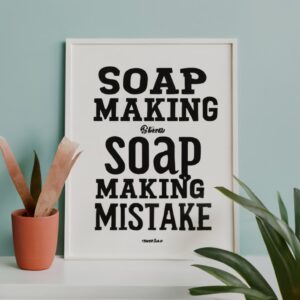
Becoming a novice soap maker often means facing a journey of unknowns, leading to inevitable mistakes. These errors can result in failed batches, wasted ingredients, and even unsafe practices, risking potential lye burns. But fear not, as even seasoned soap makers have stumbled down this slippery slope!
In my earlier soap-making days, I encountered my fair share of blunders. From bars that were drying and lacked lather to soaps resembling a swarm of bugs due to dried heather flowers turning brown in the mix. My goat milk soap even curdled, leaving me with the foulest-smelling bars this side of the Rockies. And let’s not forget the initial batches sporting an unappealing swampy grey hue!
It took years of trial, error, and practice until I perfected soap that was gentle, moisturizing, and boasted fluffy, creamy lather—alongside its visual appeal.
As your self-appointed soap-making mentor (a tad cheeky, perhaps?), I’m here to guide you and help you avoid these common soap-making pitfalls.
MISTAKES And Solutions to Fix Them

Mistake 1: Neglecting Protective Gear
During my novice days, I foolishly skipped protective gloves and goggles while making soap. Yes, it was reckless!
Lye, soap batter, and lye solutions are caustic and can cause serious chemical burns. While there’s no need to fear lye, respect its potential hazards.
The Solution:
Guard yourself with goggles and gloves throughout the soap-making process, ensuring safety from start to cleanup.
Mistake 2: Measuring by Volume Instead of Weight
Many beginners mistakenly measure soap ingredients by volume, not weight. Grabbing a measuring cup for 8 ounces of coconut oil may seem accurate, but it’s an erroneous method.
Soap recipes demand precise measurements by weight, not volume. Ounces by weight and fluid ounces differ significantly.
The Solution:
Invest in a simple digital scale for accurate ingredient measurements.
Mistake 3: Making Ingredient Substitutions
Swapping one oil for another in a soap recipe seems like an easy fix, but it’s a dangerous game. Each oil has a specific saponification value, crucial for proper soap formation.
The Solution:
Avoid oil substitutions until you’re familiar with saponification values. If necessary, use a lye calculator or seek guidance from experienced soap makers.
Mistake 4: Trusting Every Online Recipe
While numerous online soap recipes are fantastic, not all are accurately formulated. Novices lack the ability to discern inaccuracies in recipes.
The Solution:
Rely on trusted sources for soap-making recipes to ensure safe and successful results.
Mistake 5: Letting Lye Fears Hinder Progress
The fear of using lye can paralyze potential soap makers. Though daunting, with proper safety precautions, handling lye is safe.
The Solution:
Embrace safety protocols—goggles, gloves—and seek guidance from experienced soap makers for a confident start.
Convenience and Ease for Beginners:
Simplified Process: Kits often include pre-measured ingredients and step-by-step instructions, streamlining the soap making process.
Reduced Complexity: Beginner-friendly kits eliminate the need for extensive research or acquiring various raw materials, making the initial steps hassle-free.
Complete Packages with Necessary Materials and Instructions:
All-Inclusive: Kits typically contain everything needed, from soap bases to fragrances, molds, and safety gear, sparing beginners the need to source individual items.
Guidance: Detailed instructions or tutorials accompany kits, guiding users through the process and offering valuable insights.
Customization Options and Creative Freedom:
Personal Touch: Despite the convenience, kits often allow room for customization. Users can experiment with scents, colors, and additives to create unique blends.
Creative Expression: Even within the structure of a kit, there’s ample opportunity to explore creativity, enabling individuals to tailor soap to their preferences.
Tips for Successful Soap Making
Temperature Control: Discuss the importance of maintaining ideal temperatures during the soap-making process for better results.
Ingredient Quality: Emphasize using high-quality ingredients and how they can impact the final soap quality.
Mold Selection: Explain how different molds can affect the appearance and curing process of soap.
Troubleshooting Common Soap Making Issues
Solving Acceleration or Ricing: Offer solutions for when soap mixture accelerates or forms rice-like granules unexpectedly.
Addressing Separation or Seizing: Provide guidance on dealing with soap batter that separates or becomes thick too quickly.
Dealing with Discoloration: Tips on preventing or managing soap discoloration due to certain additives or ingredients.
Advanced Techniques or Additions
Layering or Swirling: Discuss techniques for creating visually appealing patterns or designs in soap.
Incorporating Botanicals: Guide readers on adding herbs, flowers, or exfoliants to enhance soap texture and appearance.
Scent Blending: Tips on creating unique and appealing fragrance combinations for customized soaps.
Curing and Storing Soap
Curing Time and Conditions: Explain the importance of curing time and optimal storage conditions for fully developed, longer-lasting soap.
Packaging and Presentation: Suggestions for attractive packaging ideas or creative ways to present
homemade soap as gifts
Showcasing Success Stories or Community Insights
Feature Real-Life Experiences: Include anecdotes or success stories from beginner soap makers or the soap-making community.
Community Recommendations: Share favorite resources, books, or online forums where soap makers can find valuable advice and support.
FAQ’S
What is Soap Making?
Soap making involves the process of creating soap bars or liquid soap using various techniques and ingredients.
Is Soap Making Safe for Beginners?
Yes, with proper precautions and following safety guidelines, soap making can be safe for beginners.
What Ingredients are Commonly Used in Soap Making?
Common ingredients include oils (like coconut, olive, or palm oil), lye (sodium hydroxide for solid soap or potassium hydroxide for liquid soap), fragrances, and additives (such as herbs, exfoliants, or colorants).
What Equipment is Needed for Soap Making?
Essential equipment includes a digital scale, mixing bowls, molds, stirring tools, safety gear (goggles, gloves), and a thermometer.
What Are the Different Methods of Soap Making?
Soap making methods include melt-and-pour, cold process, hot process, and specialty techniques like rebatching or liquid soap making.
Can I Customize My Soap?
Yes, soap making allows for customization in terms of scents, colors, additives, and even textures based on personal preferences.
How Long Does It Take to Make Soap?
The time varies based on the method used, but generally, it takes a few hours to create the soap mixture, and then several weeks for curing and hardening.
Are There Risks Associated with Soap Making?
Soap making involves working with lye, which can be caustic. Following safety measures is crucial to avoid accidents.
Can Children Engage in Soap Making?
While soap making involves working with chemicals, under strict adult supervision, children can participate in simple, safe soap-making activities.
Where Can I Find Reliable Soap Making Recipes?
Trustworthy sources like reputable websites, books dedicated to soap making, or communities of experienced soap makers often offer reliable and tested recipes.
